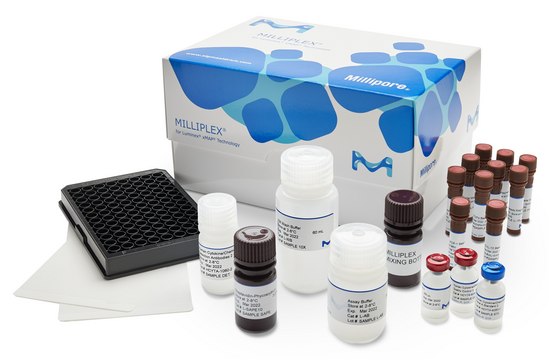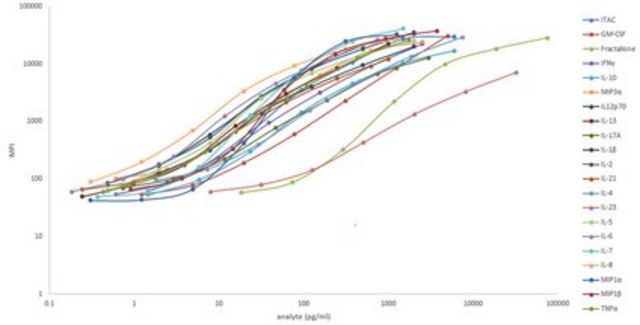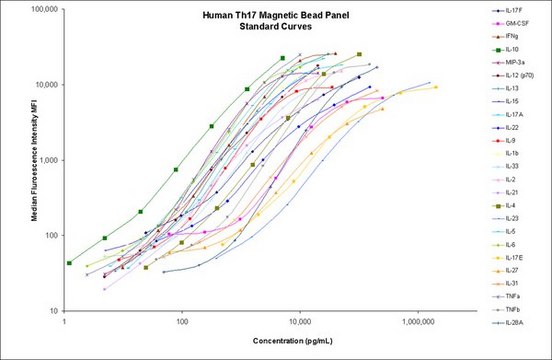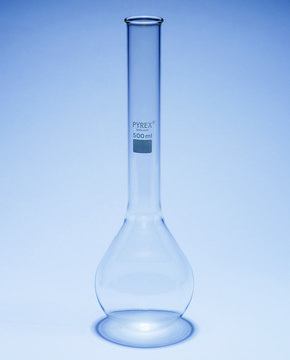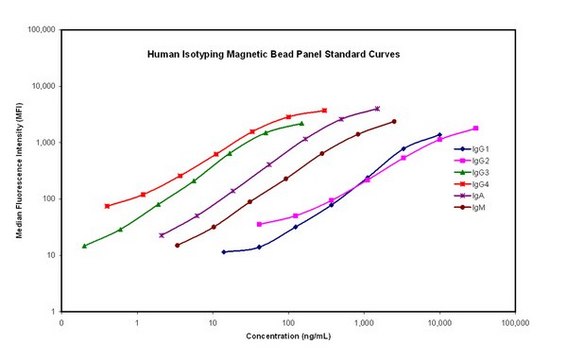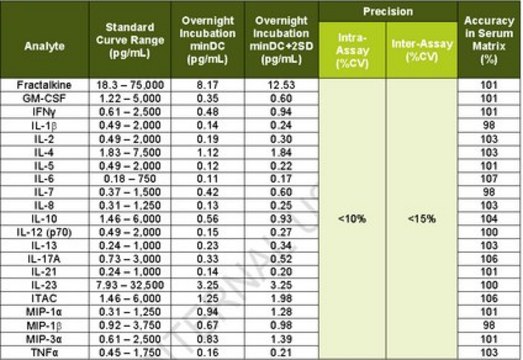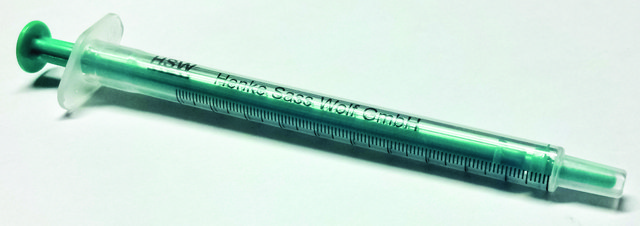HSTCMAG384-PX21
MILLIPLEX® 384-well Human High Sensitivity T Cell Premixed 21-Plex Panel - Immunology Multiplex Assay
for the analysis of a combination of analytes in serum, plasma, or tissue/cell culture supernatant
Recommended Products
Quality Level
species reactivity
human
manufacturer/tradename
Milliplex®
assay range
accuracy: 79-108%
standard curve range: 0.18-750 pg/mL
(IL-6)
standard curve range: 0.24-1,000 pg/mL
(IL-13)
standard curve range: 0.24-1,000 pg/mL
(IL-21)
standard curve range: 0.31-1,250 pg/mL
(IL-8)
standard curve range: 0.31-1,250 pg/mL
(MIP-1α)
standard curve range: 0.37-1,500 pg/mL
(IL-7)
standard curve range: 0.43-1,750 pg/mL
(TNFα)
standard curve range: 0.49-2,000 pg/mL
(IL-1β)
standard curve range: 0.49-2,000 pg/mL
(IL-12 (p70))
standard curve range: 0.49-2,000 pg/mL
(IL-2)
standard curve range: 0.49-2,000 pg/mL
(IL-5)
standard curve range: 0.61-2,500 pg/mL
(IFNγ)
standard curve range: 0.61-2,500 pg/mL
(MIP-3α)
standard curve range: 0.73-3,000 pg/mL
(IL-17A)
standard curve range: 0.92-3,750 pg/mL
(MIP-1β)
standard curve range: 1.22-5,000 pg/mL
(GM-CSF)
standard curve range: 1.46-6,000 pg/mL
(IL-10)
standard curve range: 1.46-6,000 pg/mL
(ITAC)
standard curve range: 1.83-7,500 pg/mL
(IL-4)
standard curve range: 18.3-75,000 pg/mL
(Fractalkine)
standard curve range: 7.93-32,500 pg/mL
(IL-23)
inter-assay cv: <20%
intra-assay cv: <10%
technique(s)
multiplexing: suitable
compatibility
configured for Premixed
detection method
fluorometric (Luminex xMAP)
shipped in
ambient
Related Categories
General description
Low levels of inflammation are involved in many clinical and sub-clinical disease states, such as autoimmune disease, cardiovascular disease, diabetes, neurological disorders, and cancer. Measuring picogram levels of cytokines, therefore, is critical for understanding the pathogenesis of these diseases.
The 384-well Human High Sensitivity T Cell Panel is the 384-well version of the current 96-well Human High Sensitivity T Cell Panel, and it exceeds expectations in terms of throughput, sensitivity and sample detectability.
The MILLIPLEX® 384-well Human High Sensitivity T Cell Panel is to be used for the simultaneous quantification of any or all of the above analytes in serum, plasma, or tissue/cell culture supernatant: Fractalkine/CX3CL1, GM-CSF, IFN-γ, IL-1beta, IL-2, IL-4, IL-5, IL-6, IL-7, IL-8/CXCL8, IL-10, IL-12 (p70), IL-13, IL17A/CTLA8, IL-21, IL-23, ITAC/EXCL11, MIP-1α/CCL3, MIP-1β/CCL4, MIP-3α/CCL20 and TNFα.
The Luminex® xMAP® platform uses a magnetic bead immunoassay format for ideal speed and sensitivity to quantitate multiple analytes simultaneously, dramatically improving productivity while conserving valuable sample volume.
Panel Type: Cytokines/Chemokines
Specificity
There is no detectable cross-reactivity within the panel.
Application
- Analytes: Fractalkine, GM-CSF, IFNγ, IL-1β, IL-2, IL-4, IL-5, IL-6, IL-7, IL-8, IL-10, IL-12 (p70), IL-13, IL-17A, IL-21, IL-23, I-TAC, MIP-1α, MIP-1β, MIP-3α, TNF-α
- Because there are unique features concerning sample prep and assay set-up, please read the entire protocol before running the assay.
- Recommended Sample type: Serum, plasma or tissue/cell lysate and culture supernatant
- Assay Run Time: Overnight
- Research Category: Inflammation & Immunology
- Research Subcategory: Immune Response, Metabolic Disorders, Chronic Inflammatory Disease, Cardiovascular Disease, Neuroscience
Storage and Stability
Other Notes
Legal Information
Disclaimer
Signal Word
Danger
Hazard Statements
Precautionary Statements
Hazard Classifications
Acute Tox. 4 Dermal - Acute Tox. 4 Inhalation - Acute Tox. 4 Oral - Aquatic Chronic 2 - Eye Dam. 1 - Skin Sens. 1 - STOT RE 2
Target Organs
Respiratory Tract
WGK
WGK 3
Regulatory Information
Certificates of Analysis (COA)
Search for Certificates of Analysis (COA) by entering the products Lot/Batch Number. Lot and Batch Numbers can be found on a product’s label following the words ‘Lot’ or ‘Batch’.
Already Own This Product?
Find documentation for the products that you have recently purchased in the Document Library.
Our team of scientists has experience in all areas of research including Life Science, Material Science, Chemical Synthesis, Chromatography, Analytical and many others.
Contact Technical Service